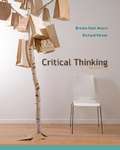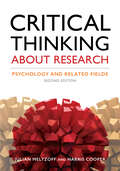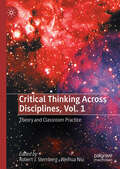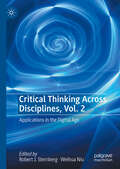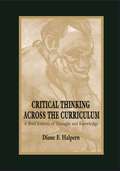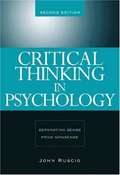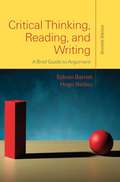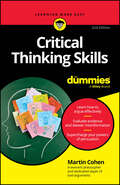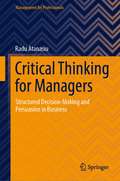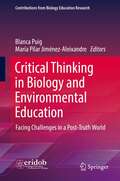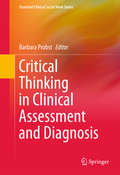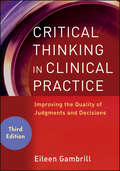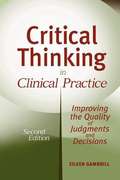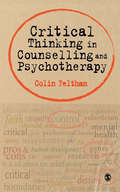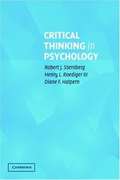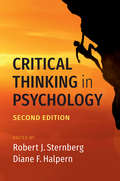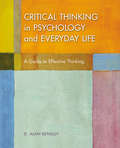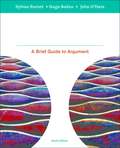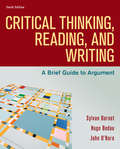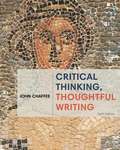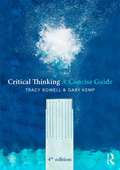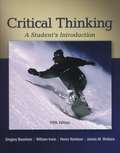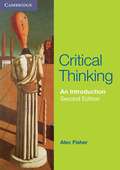- Table View
- List View
Critical Thinking (9th edition)
by Richard Parker Brooke Noel MooreMore than any other textbook, Moore and Parker's Critical Thinking has defined the structure and content of the critical thinking course at colleges and universities across the country--and has done so with a witty writing style that students enjoy. Current examples relevant to today's students bring the concepts of critical thinking to life in vivid detail. This ninth edition offers an abundance of new exercises and examples, as well as a renewed focus on the importance of developing critical thinking skills.
Critical Thinking About Research: Psychology and Related Fields
by Dr. Harris Cooper Julian Meltzoff PhDTo become informed consumers of research, students need to thoughtfully evaluate the research they read rather than accept it without question. This second edition of a classic text gives students what they need to apply critical reasoning when reading behavioral science research. This second edition updates the original text with recent developments in research methods, including a new chapter on meta-analyses. Part I gives a thorough overview of the steps in a research project. It focuses on how to assess whether the conclusions drawn in a behavioral science report are warranted by the methods used in the research. Topics include research hypotheses, sampling, experimental design, data analysis, interpretation of results, and ethics. Part II allows readers to practice critical thinking with a series of fictitious journal articles containing built-in flaws in method and interpretation. Clever and engaging, each article is accompanied by a commentary that points out the errors of procedure and logic that have been deliberately embedded in the article. This combination of instruction and practical application will promote active learning and critical thinking in students studying the behavioral sciences.
Critical Thinking Across Disciplines, Vol. 1: Theory and Classroom Practice
by Robert J. Sternberg Weihua NiuThis edited collection adopts a multidisciplinary perspective on critical thinking, bringing together leading experts from fields such as psychology, philosophy, education, and creativity studies. It explores both the theoretical foundations and practical applications of critical thinking in the classroom. By integrating diverse approaches, the book aims to foster a richer dialogue and deeper understanding of critical thinking, while enhancing its application to address emerging challenges in the first quarter of the 21st century, including global pandemics, geopolitical tensions, and the rise of generative AI. Volume 1 offers a comprehensive survey of cutting-edge multidisciplinary research, laying the groundwork for Volume 2, which will delve into the application of critical thinking to contemporary issues such as artificial intelligence, misinformation, and health communication.
Critical Thinking Across Disciplines, Vol. 2: Applications in the Digital Age
by Robert J. Sternberg Weihua NiuThis edited collection takes a multidisciplinary approach to critical thinking, drawing together leading experts to examine its application to contemporary societal issues including AI, misinformation, and health communication. Where Volume 1 initiated a dialogue between disciplines to enable a deeper understanding of critical thinking, Volume 2 considers how we might best apply critical-thinking skills to meet challenges in our everyday lives. Drawing together leading experts from disciplines including psychology, philosophy, education, and creativity studies, the book&’s authors consider topics ranging from conspiracy beliefs and bio-ethics, to multiculturalism and social justice. This compelling work offers fresh insights for students, scholars and those with a general interest in the application and development of critical thinking skills.
Critical Thinking Across the Curriculum: A Brief Edition of Thought & Knowledge
by Diane F. HalpernConsider that many of the people who are alive today will be working at jobs that do not currently exist and that the explosion of information means that today's knowledge will quickly become outdated. As a result, two goals for education clearly emerge -- learning how to learn and how to think critically about information that changes at a rapid rate. We face a multitude of new challenges to our natural environment, difficult dilemmas concerning the use of weapons of mass destruction, political agendas for the distribution of scarce commodities and wealth, psychological problems of loneliness and depression, escalating violence, and an expanding elderly population. International in scope and in magnitude, these new problems strain resources and threaten the continuance of life on earth. To creatively and effectively attack these imminent problems, a well educated, thinking populace is essential. An abridged edition of Halpern's best-selling text, Critical Thinking Across the Curriculum is designed to help students enhance their thinking skills in every class. The skills discussed are needed in every academic area and setting -- both in and out of class. They are: determining cause; assessing likelihood and uncertainty; comprehending complex text; solving novel problems; making good decisions; evaluating claims and evidence; and thinking creatively. In this adaptation of her best-selling text, Diane Halpern applies the theories and research of cognitive psychology to the development of critical thinking and learning skills needed in the increasingly complex world in which we work and live. The book is distinguished by its clear writing style, humorous tone, many practical examples and anecdotes, and rigorous academic grounding. Everyday examples and exercises promote the transfer of critical thinking skills and dispositions to real-world settings and problems. The goal is to help readers recognize when and how to apply the thinking skills needed to analyze arguments, reason clearly, identify and solve problems, and make sound decisions. Also of importance, a general thinking skills framework ties the chapters together, but each is written so that it can "stand alone." This organization allows for maximum flexibility in the selection of topics and the order in which they are covered. This book is intended for use in any course emphasizing critical thinking as an approach to excellence in thinking and learning.
Critical Thinking In Psychology: Separating Sense From Nonsense
by John RuscioDo your students have the tools to distinguish between the true science of human thought and behavior from pop psychology? John Ruscio's book provides a tangible and compelling framework for making that distinction. Because we are inundated with "scientific" claims, the author does not merely differentiate science and pseudoscience, but goes further to teach the fundamentals of scientific reasoning on which students can base their evaluation of information.
Critical Thinking Reading and Writing: A Brief Guide to Argument (7th edition)
by Sylvan Barnet Hugo BedauCritical Thinking, Reading, and Writing is a compact but complete guide to critical thinking and argumentation. Comprising the text portion of the widely adopted Current Issues and Enduring Questions, it draws on the authors' dual expertise in effective persuasive writing and comprehensive rhetorical strategies to help students move from critical thinking to argumentative and researched writing. With comprehensive coverage of classic and contemporary approaches to argument, including Aristotle, Toulmin, and a range of alternative views, as well as 35 readings and a casebook on the state and the individual, it is an extraordinarily versatile text. This affordable guide can stand alone or supplement a larger anthology of readings.
Critical Thinking Skills For Dummies
by Martin CohenLearn how to argue points effectively, analyze information, and make sound judgments The ability to think clearly and critically is a lifelong benefit that you can apply in any situation that calls for reflection, analysis, and planning. Being able to think systematically and solve problems is also a great career asset. Critical Thinking Skills For Dummies helps you hone your thinking abilities and become a better communicator. You’ll find hands-on, active instruction and exercises that you can put to work today as you navigate social media and news websites, chat with AI, fact-check your own and others’ views, and more. Become a thinking machine, with this Dummies guide. Identify other people’s arguments and conclusions—and spot holes in them Evaluate evidence and produce more effective arguments in any situation Read between the lines of what people say and form your own judgments Apply critical thinking to school or college assignments to improve your academic performance This is the perfect Dummies title for students, researchers, and everyone who seeks to improve their reasoning and analysis ability.
Critical Thinking for Managers: Structured Decision-Making and Persuasion in Business (Management for Professionals)
by Radu AtanasiuThis book discusses critical thinking as a tool for more compassionate leadership, presenting tried and tested methods for managing disagreement, for anticipating and solving problems, and for enhancing empathy. Employing a lighter tone of voice than most management books, it also shows how and when less-than-rational mechanisms such as intuition and heuristics may be efficient decision-making tools in any manager’s toolbox. Critical thinking is useful for analyzing incoming information in the context of decision-making and is crucial for structuring outgoing information in the context of persuasion. When trying to convince a client to buy a service, an executive board to fund a project, or a colleague to change a procedure, managers can use the simple step-by-step guides provided here to prepare for successful meetings and effective pitches.Managerial thinking can be steadily improved, using a structured process, especially if we learn to think about our thinking. This book guides current and would-be managers through this process of improving and metathinking, in connection with decision-making and persuasion. Using examples from business, together with research insights from Behavioral Economics and from Management and Organizational Cognition, the author illustrates common pitfalls like hidden assumptions and cognitive biases, and provides easy-to-use solutions for testing hypotheses and resolving dilemmas.
Critical Thinking in Biology and Environmental Education: Facing Challenges in a Post-Truth World (Contributions from Biology Education Research)
by Blanca Puig María Pilar Jiménez-AleixandreThis volume seeks to broaden current ideas about the role of critical thinking (CT) in biology and environmental education considering educational challenges in the post-truth era. The chapters are distributed into three sections, perspectives of a theoretical character (part I), empirical research about CT in the context of biology and health education (part II), and empirical research on CT in the context of environmental and sustainability education (part III). The volume includes studies reporting students’ engagement in the practice of critical thinking, and displays how CT can be integrated in biology and environmental education and why biology and environmental issues are privileged contexts for the development of CT. The chapters examine a range of dimensions of CT, such as skills, dispositions, emotions, agency, open-mindedness, or personal epistemologies. In addition, they explore topics such as climate change, sustainable diets, genetically modified food, vaccination, acceptance of evolution, homeopathy, and gene cloning. Concluding remarks regarding the connections between the chapters and future directions for the integration of critical thinking in biology and environmental education are presented in a final chapter.
Critical Thinking in Clinical Assessment and Diagnosis (Essential Clinical Social Work Series)
by Barbara Probst"This much-needed volume brings to the clinician or student some of the best critical-minded analysis by some of the most insightful thinkers about psychiatric diagnosis today. The thought-provoking questions these essays raise, and the multifaceted and provocative answers they provide, cultivate sensitivity to the nuances of diagnostic assessment that often makes the difference between clinical success and failure. " - Jerome C. Wakefield, PhD, DSW, New York University Silver School of Social Work, New York This transformative resource challenges social workers and mental health professionals to rethink their approaches to assessment and diagnosis from the ground up. Among the book's unique features are its use of diverse lenses to examine a common case and its illustration of how multiple perspectives can be integrated for a richly textured portrait of the individual in context. Equally crucial is the book's commitment to professional development, from exercises to improve case conceptualization to strategies for teaching and learning. Topics include: The DSM-5 definition of mental disorder: critique and alternatives. Making assessment decisions: macro, mezzo, and micro perspectives. Neuroscience, resilience, and the embodiment of "mental" disorder. Narrative, psychodynamic, and cultural conceptualizations of disorder. Person-centered and contextualized diagnosis in mental health. Meeting the challenge of teaching integrated assessment. Critical Thinking in Clinical Assessment and Diagnosis has much to offer professionals, researchers, and educators in the fields of social work and mental health. .
Critical Thinking in Clinical Practice
by Eileen GambrillPraise for Critical Thinking in Clinical Practice, Third Edition "Eileen Gambrill is unparalleled in her ability to describe common flaws and biases in clinical decision making. The result in this revised edition is a steadfast call for change that also acknowledges the demands of practice. A must-read for clinicians and researchers alike. " --Elizabeth K. Anthony, PhD, Assistant Professor, School of Social Work, Arizona State University "This Third Edition builds upon the impressive strengths of Gambrill's prior treatments of the topic to support the notion that critical thinking is a teachable skill and one essential for contemporary practice in the human services. This book should be the default authority on the topic of critical thinking for human service professionals and would be an excellent textbook. " --Bruce A. Thyer, PhD, LCSW, Professor and former Dean, Florida State University College of Social Work "I was skeptical about how Critical Thinking in Clinical Practice could be improved, but Eileen Gambrill has succeeded! Her articulation of critical thinking skills for clinical decisions ultimately will benefit the people we serve. " --Joanne Yaffe, PhD, ACSW, Associate Professor of Social Work and Adjunct Associate Professor of Psychiatry, University of Utah A balanced and illustrative guide to incorporating critical-thinking values, knowledge, and skills into clinical education and practice Now in a third edition, Critical Thinking in Clinical Practice is written for helping professionals who want to think more clearly about the decisions they make and the context in which they make them. It is a practical volume for clinicians who would like to expand their knowledge of common pitfalls and fallacies in clinical reasoning. As in earlier editions, this Third Edition draws on research related to problem solving and decision making, illustrating the relevance of research findings to everyday clinical practice and policy. Revised throughout, the new edition includes discussion of: The influence of pharmaceutical companies on the helping professions, including disease mongering--the creation of bogus risks, problems, and needless worries Different kinds of propaganda in the helping professions that compromise informed consent Additional coverage of classification, pathology, reliance on authority, and hazards in data collection The development of decision aids of value to both professionals and clients The relative contribution of specific interventions compared to nonspecific factors to positive outcome Factors related to decision making in multidisciplinary teams New developments regarding intuitive and analytic reasoning The pragmatic theory of fallacies Designed to enhance the quality of services offered to clients, Critical Thinking in Clinical Practice, Third Edition is filled with insightful examples, useful lists, websites, and guidelines, presenting an essential resource for all helping professionals and students in the helping professions.
Critical Thinking in Clinical Practice: Improving the Quality of Judgments and Decisions (2nd edition)
by Eileen GambrillDecisions are influenced by a variety of fallacies and biases that we can learn how to avoid. Critical thinking values, knowledge, and skills, therefore, are integral to evidence-based practice. These emphasize the importance of recognizing ignorance as well as knowledge and the vital role of criticism in discovering how to make better decisions. This book is for clinicians--clinicians who are willing to say "I don't know. " Critical Thinking in Clinical Practice, Second Edition is designed to enhance readers' skills in making well-informed, ethical decisions. Making such decisions is no easy task. Decisions are made in uncertain, changing environments with time pressures. Interested parties, such as the pharmaceutical industry, spend millions of dollars to influence decisions made. Drawing on a wide range of related literature, this book describes common pitfalls in clinical reasoning as well as strategies for avoiding them--sometimes called mind-tools. Mental health and allied professionals will come away from this text with knowledge of how classification decisions, a focus on pathology, and reliance on popularity can cause errors. Hazards involved in data collection and team decision making such as groupthink are discussed. Part 1 provides an overview of the context in which clinicians make decisions. Part 2 describes common sources of error, and Part 3 describes decision aids including the process of evidence-based practice. Part 4 describes the application of related content to different helping phases including assessment, intervention, and evaluation. Part 5 suggests obstacles to making well-informed decisions and how to encourage lifelong learning. This new Second Edition has been completely updated with expanded coverage on: * Evidence-based practice * Screening issues and practice errors * Lifelong learning * Problem solving * Decision making An interactive, dynamic book filled with insightful examples, useful lists and guidelines, and exercises geared to encourage critical thinking, Critical Thinking in Clinical Practice, Second Edition provides an essential resource for helping professionals and students.
Critical Thinking in Counselling and Psychotherapy
by Colin FelthamThis innovative new textbook examines the critical debates around key topics in counselling and psychotherapy. In nine sections including Everyday Counselling Practice, Training and Curriculum Issues, and Counselling, Society and Culture, Colin Feltham explores 60 provocative questions central to counselling training and practice. Ranging from more mainstream subjects like unconditional positive regard, ethics and supervision to broader social or philosophical issues such as employment concerns and the debate on assisted suicide, entries include: - Why have we focused on core theoretical models? - What are the pros and cons of short-term, time-limited counselling? - What′s wrong with CBT? - Where is research taking us? - Is statutory regulation a good and inevitable development? - Are there limits to personal change in counselling? Each section includes questions for reflection, case studies and student exercises. This comprehensive, student-friendly text is a useful resource for lecturers to stimulate seminar discussion, and for all trainees wishing to write essays or generally develop their critical thinking in counselling and psychotherapy.
Critical Thinking in Psychology
by D. Alan BensleyThis book was written for students and instructors who are serious about the improvement of critical thinking
Critical Thinking in Psychology
by Robert J. Sternberg Diane F. Halpern Henry L. RoedigerGood scientific research depends on critical thinking at least as much as factual knowledge; psychology is no exception to this rule. And yet, despite the importance of critical thinking, psychology students are rarely taught how to think critically about the theories, methods, and concepts they must use. This book shows students and researchers how to think critically about key topics such as experimental research, statistical inference, case studies, logical fallacies, and ethical judgments.
Critical Thinking in Psychology
by Robert J. Sternberg Diane F. HalpernGood scientific research depends on critical thinking at least as much as factual knowledge; psychology is no exception to this rule. And yet, despite the importance of critical thinking, psychology students are rarely taught how to think critically about the theories, methods, and concepts they must use. This book shows students and researchers how to think critically about key topics such as experimental research, statistical inference, case studies, logical fallacies, and ethical judgments. Using updated research findings and new insights, this volume provides a comprehensive overview of what critical thinking is and how to teach it in psychology. Written by leading experts in critical thinking in psychology, each chapter contains useful pedagogical features, such as critical-thinking questions, brief summaries, and definitions of key terms. It also supplies descriptions of each chapter author's critical-thinking experience, which evidences how critical thinking has made a difference to facilitating career development.
Critical Thinking in Psychology and Everyday Life: A Guide to Effective Thinking
by D. Alan BensleyCritical Thinking in Psychology and Everyday Life shows how a scientific, critical thinking approach can be effective in addressing psychological questions, and discusses other questions that straddle the boundary between science and non-science. While scientific, critical thinking can be effective in addressing psychological questions, this textbook is a guide for how to separate fact from speculation and true claims from misconceptions and misinformation. Covering a wide range of topics, this book seeks to engage students in a serious search for answers, using what psychologists and other scientists know about how to think effectively. What does science have to say about whether some people have special psychic abilities, such as being able to "see" the future? Can people use their minds to move objects without any physical aid? Does the mind actually leave the body during an out-of-body experience? You may be surprised to learn that we are tantalizingly close to a scientific answer to this last question (see Chapter 7).
Critical Thinking, Reading And Writing: A Brief Guide To Argument
by John O'Hara Sylvan Barnet Hugo BedauCritical Thinking, Reading, and Writing is a compact but complete guide to critical thinking and argumentation. Comprising the text portion of the widely adopted Current Issues and Enduring Questions, it draws on the authors’ dual expertise in effective persuasive writing and comprehensive rhetorical strategies to help students move from critical thinking to argumentative and researched writing. With comprehensive coverage of classic and contemporary approaches to argument, including Aristotle, Toulmin, and a range of alternative views, as well as 35 readings and a casebook on the state and the individual, it is an extraordinarily versatile text. This affordable guide can stand alone or supplement a larger anthology of readings.
Critical Thinking, Reading, and Writing
by Sylvan Barnet Hugo Bedau John O’haraCritical Thinking, Reading, and Writing is a compact but complete guide to critical thinking and argumentation. Comprising the text portion of the widely adopted Current Issues and Enduring Questions, it draws on the authors’ dual expertise in effective persuasive writing and comprehensive rhetorical strategies to help students move from critical thinking to argumentative and researched writing. This extraordinarily versatile text includes comprehensive coverage of classic and contemporary approaches to argument, from Aristotelian to Toulmin, to a new chapter on rhetorical analysis of pop culture texts, as well as 35 readings (including e-Pages that allow students to take advantage of working with multimodal arguments on the Web), and a casebook on the state and the individual. This affordable guide can stand alone or supplement a larger anthology of readings.
Critical Thinking, Reading, and Writing: A Brief Guide To Argument
by Sylvan Barnet Hugo Bedau John O’HaraCritical Thinking, Reading, and Writing is a brief yet versatile resource for teaching argument, persuasive writing, and research. It makes argument concepts clear and gives students strategies to move from critical thinking and analysis to crafting effective arguments. Comprehensive coverage of classic and contemporary approaches to argument ― Aristotelian, Toulmin, Rogerian, visual argument, and more ― provides a foundation for nearly 50 readings on current issues, such as student loan forgiveness and gun violence, topics that students will want to engage with and debate. For today’s ever-increasingly visual learners who are challenged to separate what’s real from what’s not, new activities and visual flowcharts support information literacy, and newly annotated readings highlight important rhetorical moves. This affordable guide can stand alone or supplement a larger anthology of readings.
Critical Thinking, Thoughtful Writing, 6th Edition
by John ChaffeeEmphasizing that thinking well and writing well are invariably connected, CRITICAL THINKING, THOUGHTFUL WRITING, 6e delivers thorough coverage of the writing process, going beyond the traditional rhetoric to teach you how to evaluate sources, images, and arguments. This rhetoric with readings introduces the process of thinking critically as a powerful approach to writing, to critically evaluating electronic and visual media, and to life in general. Each chapter focuses on a critical-thinking skill--such as problem solving or analysis of complex issues--that is explored through Thinking-Writing Activities and thematically linked readings. Each of the readings challenges you to read actively, think critically, and then write about the readings. The Sixth Edition offers provocative new readings, a four-color interior design, expanded writing projects that help you fully interact with the writing process, annotations to student essays, and more in-chapter questions to help you reflect on the material.
Critical Thinking: A Concise Guide (4th Edition)
by Tracy Bowell Gary KempWe are frequently confronted with arguments. Arguments are attempts to persuade us #65533; to influence our beliefs and actions #65533; by giving us reasons to believe this or that. Critical Thinking: A Concise Guide will equip students with the concepts and techniques used in the identification, analysis and assessment of arguments. Through precise and accessible discussion, this book provides the tools to become a successful critical thinker, one who can act and believe in accordance with good reasons, and who can articulate and make explicit those reasons. Key topics discussed include: core concepts in argumentation how language can serve to obscure or conceal the real content of arguments; how to distinguish argumentation from rhetoric how to avoid common confusions surrounding words such as #65533;truth#65533;, #65533;knowledge#65533; and #65533;opinion#65533; how to identify and evaluate the most common types of argument how to distinguish good reasoning from bad in terms of deductive validly and induction. This fourth edition has been revised and updated throughout, with a new introduction for each chapter and up-to-date topical examples. Particular revisions include: practical reasoning; understanding quantitative data, statistics, and the rhetoric used about them; scientific reasoning; the connection to formal logic and the logic of probability; conditionals; ambiguity; vagueness; slippery slope arguments; and arguments by analogy. The dynamic Routledge Critical Thinking companion website provides thoroughly updated resources for both instructors and students including new examples and case studies, flashcards, sample questions, practice questions and answers, student activities and a testbank of questions for use in the classroom.
Critical Thinking: A Student's Introduction (Fifth Edition)
by William Irwin Gregory Bassham Henry Nardone James WallaceBassham's popular text helps today's students bridge the gap between everyday culture and critical thinking. Using a proven step-by-step approach, this text covers all the basics of critical thinking in clear, reader-friendly language. The 5th edition has taken into account suggestions from users and reviewers of previous editions, and has added an Appendix, and new readings, exercises and examples throughout the text.
Critical Thinking: An Introduction (Second Edition)
by Alec FisherThis second edition has been extensively revised with updated examples and a brand new chapter on how to obtain reliable information from the internet. Studying critical thinking involves trying to change the ways in which most of us think. In this second edition of the popular 'Critical Thinking: An Introduction', Alec Fisher concentrates on developing critical thinking skills explicitly and directly. His aim is to teach the ability to interpret, analyse and evaluate ideas and arguments and to show how these skills can be transferred to other studies and everyday life. A new chapter covers getting reliable information from the internet and examples and passages have been replaced by completely new material. The book is also suitable for the independent learner.
